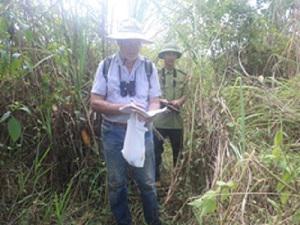Thi Phuong Hoang
The project's aim is to study and assess the status and distribution of Tiger prey species populations, develop the conservation strategies and identify priority protection measures both for Tigers and their prey.

Hoof animal wallow.
The project bases on Chu Mom Ray National Park, which is one of 5 Parks of Central Vietnam where Tigers still occur. This park is an ASEAN Heritage site and a key conservation area for large herbivores and carnivores. It is adjacent to the Virachey National Park in Cambodia and to the Dong Giang Pham National Park in Laos, all together forming a triangular cross-border forest landscape complex of 700,000 hectares. It is one of the very few areas large enough to serve as a refuge for one of the last tiger populations in South-East Asia. Chu Mom Ray NP has rich forests as well as large grasslands and shrub areas, many streams and rivers, high mountains and also lower hills surrounding the valleys. This variety of habitats is very suitable for large animals like Gaur, Banteng, Deer and Tiger. These rare animals are of high conservation priority and severely threatened by illegal hunting or poaching.

My team.
Urgent conservation strategies and measures for these rare species are needed to protect them against extinction, based on good knowledge of their status and distribution. The project aims to contribute to the conservation of remaining Tigers and their prey species populations by studying and assessing the status and distribution of Tiger prey species populations, in particular sambar deer, red muntjac, wild banteng cattle, gaur buffaloes and wild boar. These prey species are critical for survival of tigers in the wild. The results are expected to allow conclusions on the prey populations’ viability and role as food resources for remaining Tiger individuals in the region and in nearby protected areas in Cambodia and Laos and to highlight protection measures addressing current threats. Based on data gathered in the field, the conservation strategies will be developed and priority protection measures identified, both for Tigers and their prey.